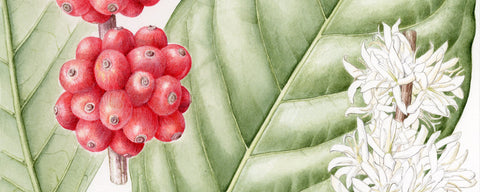By Pascale Schuit & Steven Macatonia
Humans influence nature in many ways. What we grow and consume and how we move around affects the earth. The impact of humans on our environment is widespread in both terrestrial and aquatic ecosystems and specific farming techniques used to grow coffee are no exception to this.
By being aware of these influences we can take action to reduce the negative effects on the environment as much as possible. This is vital if we want to protect the earth for future generations.
But how do we do this?
Although not everyone who works with coffee, or in the wider agriculture sector, shares the same definitions of what sustainable coffee production looks like, most people will concur that it must provide a benefit to the land, to people and it should provide a profit, to make it a viable activity. This establishes the link between the environment, society and the economy. Sustainable agriculture means embracing practices that at very least maintain the land at a certain level, ideally enhancing its quality and reducing the amount of damage or harm on the environment.
Every farm that undertakes a programme of sustainable production will begin at a different point. For example the farm may have more or fewer tree species, or soil quality may require more or less intervention to achieve optimum performance.
When the impact of climate change becomes noticeable on a farm, or when new technologies arise or new insights are obtained, the farm may need to change their plan. The journey that one farm takes compared to another might be different, although it does not make one farms journey to sustainability better than another.
Strategies to achieve sustainable agriculture

Organic Farming
This is a method of agricultural production that excludes the use of synthetic substances, such as pesticides or fertilisers and genetically modified organisms. Farms achieve this by using ecologically based pest-controls and biological fertilisers derived largely from animal and plant waste and nitrogen-fixing cover crops. Organic production maintains the health of the soil, surrounding forests and farm workers.
Coffee can only be legally defined as organic after a 3 year conversion into organic farming methods. The farm is inspected by a third-party agency to audit and verify that the farm is managed according to defined organic standards. In the UK, organic coffees must be approved by an organic certifying licensor. At Union we work with the Soil Association Ltd.
Only 6.7% (about 700,000 hectares) of coffee’s global cropland is organic (The world of organic agriculture, 2021). Most of this organic production is commercial (mainstream) quality with only a small fraction of this attributed as organic specialty arabica, which is the type of quality that Union seeks. Ethiopia has the largest production with over 160,000 ha. followed by Peru with 102,730 ha which represents 0.2% of the land that is planted as organic.
The world’s largest coffee producer, Brazil, certifies 0.2% of coffee production as organic. Compared to conventional agriculture, organic coffee production is more labour intensive and yields less per hectare which increases the cost of production. Adding the cost of certification and compliance, it becomes economically unfeasible for many coffee growers to obtain organic certification.

Although organic coffee production does not guarantee that human and labour rights standards are complied with, one of the most salient risks in coffee production, exposure to hazardous and toxic materials, is eliminated.
Organic coffee does achieve a price premium. From August 2023, the premium for organic coffee increases from USD $0.30 per LB to USD $0.40 cents per LB. Specialty organic coffee often comes at even heftier price premiums because of its limited supply. Coffee varieties with special flavour and attribute characteristics (Geisha, Bourbon, Pacamara, Kenya etc) are often low yielding and highly vulnerable to pest and disease (unlike the very hardy, but different tasting “Robusta” species). Growing these exotic varieties under organic conditions is high risk because low to zero yields as a result of pest gives no income.
Within our Union Direct Trade network, we have a wide range of partners that are organic certified; Aprocassi, Huadquiña, Prosperidad de Chirinos & San Jose Olaya (Peru), Bella Vista, Cafescor & Cocafelol (Honduras), Fedecovera (Guatemala), Aldea Global (Nicaragua), Sidama Coffee Farmers Cooperative Union, Sorgeba Coffee Farmers Cooperative Union, and Yirgacheffe Union Coffee Farmers Cooperative Union. Our partners at Cocagi in Rwanda are transitioning to organic production. However, beyond this, many farms we work with embrace an organic philosophy by promoting biodiversity, eliminating or reducing synthetic chemical inputs and weeding by hand. But they do not follow the official track with audits and certification and cannot be named as organic.
Third-party certification
There is a wide variety of approaches that can be taken to achieve sustainable or regenerative outcomes, but the correct solution is likely to vary from farm to farm.
Third party certification may be one of the approaches taken when implementing practices stated by Rainforest, or organic standards. One advantage to the consumer is the confidence that any beneficial claims are verified by independent, external inspections. This differs from first-party inspections, where the farm self-attests to compliance, and second-party verification where the inspection is undertaken by a person that has some connection (trainer/instructor) to the farm.
Achieving certification for farmers and for roasters will incur costs which will be reflected in the price of the finished goods, likely making them more expensive than non-certification. This is one of the challenges in making sustainable coffee mainstream. It costs more to do the right thing, and prove you are doing the right thing and not harming anyone.
With so many claims and options for different approaches to sustainability, we do not want consumers to become confused and just be tempted to choose the most price competitive, but unsustainably produced coffee. The outcome will be that fewer resources are available to invest in sustainable practices.

Regenerative agriculture
If sustainable agriculture means taking action to maintain the land at a certain level to reduce harm, then regenerative agriculture is about interventions to make improvements and replenishment of the environment.
We know that about 38% of global agricultural land is already affected by degradation. For this reason, we have to ask if “sustainable” will be enough for the land to provide for us into the future. We need to regenerate and improve to have a true positive environmental impact. It is important to consider the impact of ‘regenerative’ versus ‘sustainable’ in relation to land and agriculture. Regeneration describes repairing what has been damaged, completely transforming the land, replacing vital nutrients, and restoring biodiversity.
Although regenerative agriculture was defined more than 50 years ago, it is only in recent years that the practice has gained a higher profile. Following similar principles described above for organic standards, food crops, including coffee can only be defined as regenerative if the production methods have been audited and certified. Regenerative agricultural certifications are relatively new, with Regenerative Organic Certified probably the most relevant to coffee.

Weeds must be controlled, but herbicides are not the answer. Weeds have an important function by providing ground cover that reduces erosion losses and retains moisture, and through producing root exudates, in the form of sugars and proteins. These promote the growth of beneficial bacteria and fungi in the soil, providing a source of nutrients for the coffee trees. Weeds are controlled by trimming, which reduces soil disturbance. By intercropping with banana and maize, alongside indigenous shade trees, this provides diversity above and below ground.
Regenerative agriculture is a collection of practices that focus on reviving soil health and full farm ecosystems. These actions go beyond reducing harm and actively seek to restore and revitalise natural systems through innovative and restorative practices. Sustainability shifts from “doing no or less harm” to “doing better”.
In practice, regenerative agriculture will include; cover cropping to prevent soil erosion and increase nutrients in the soil, crop rotation, low-to no-tillage, composting and reducing reliance on synthetic and non-renewable inputs. Organic regenerative agriculture also further means zero use of chemical pesticides and fertilisers1.
Farmers who farm regeneratively recognise that success goes beyond yield and farm size. It includes aspects like healthy soils, increasing biodiversity that provides habitats for birds, insects and small mammals on the farm and taking actions that restore natural springs which had dried out enabling them to fill with water again.
Regenerative is aligned with Biodynamic farming systems, although it extends to practices that include activities synchronised with the lunar and astrological farming calendar.
A philosophical way of explaining regenerative farming is talking about “growing coffee in harmony with nature”. This is not a new idea because indigenous communities have farmed in nature’s image for millennia. In the west we started taking animals out of the cropping system in the 20th century. But in developing countries, where many people live off subsistence agriculture, cropping, composting and zero to low synthetic inputs are “standard” farming practices.
Smallholder farmers we work with in Rwanda, intercrop their coffee plants with bananas, use goat and cow manure to fertilise their coffee plantations.
Smallholders in Guatemala plant green cover crops between the rows of coffee trees, which are screened from the sun by a wide range of indigenous varieties of shade trees providing a habitat and food source for insects, birds and small mammals.
And at Finca Candelaria, Guatemala, they have eliminated the use of herbicides, by mulching (soil is covered by organic matter), every day of the year to prevent weeds, and if any appear they are removed by hand.
They can now control Leaf Rust fungus using an organic leaf foliate, and they are increasing biodiversity by planting different species of shade tree and inoculating the soil with EM (extraordinary microorganisms). The tiniest creatures that live on farms that provide suitable conditions, such as the 200,000 species of pollinators (e.g. birds, bats, and bees) are vital to ecosystems and food production.
These measures, which enrich the land, are regenerative agricultural practices defined in our Union Code of Conduct. It is worth noting that coffee certifications promoting sustainable practices such as Fairtrade and Rainforest Alliance include practices in their standards that would be classified as “regenerative”.
Agroforestry, which is the practice of cultivating crops amid native trees, and establishing wildlife corridors are powerful ways of boosting all-around biodiversity.
Soil can act as both a carbon pool (reservoir) and carbon sink (a mechanism that removes greenhouse gases from the atmosphere).
A healthy soil, an outcome of regenerative agriculture, helps mitigate the impact of climate change.
Footnotes
-
Pesticides and synthetic chemicals
Pesticides can be incredibly beneficial and have certainly increased food production in recent decades. Yet we are now aware that the detrimental effects outweigh the positive ones. Pesticides can be extremely hazardous to the human body and other living organisms, as they are designed to be a poison. Minimising pesticides, preferably to zero is the ideal outcome but not always feasible.
Misuse of pesticides by farm workers, typically stems from their lack of awareness of the harmful effects on their families, the environment and themselves. In addition, workers are rarely fitted-out with equipment that provides them with all the protection they need against these pollutants. A challenge at origin is that even when workers are provided with personal protective equipment, it is hot and uncomfortable to wear and limits their movements. ↵


